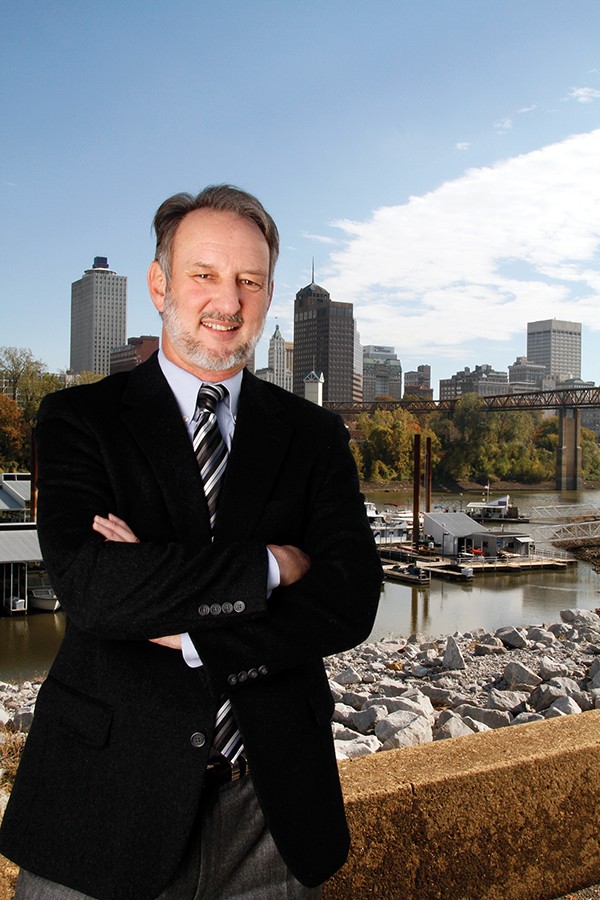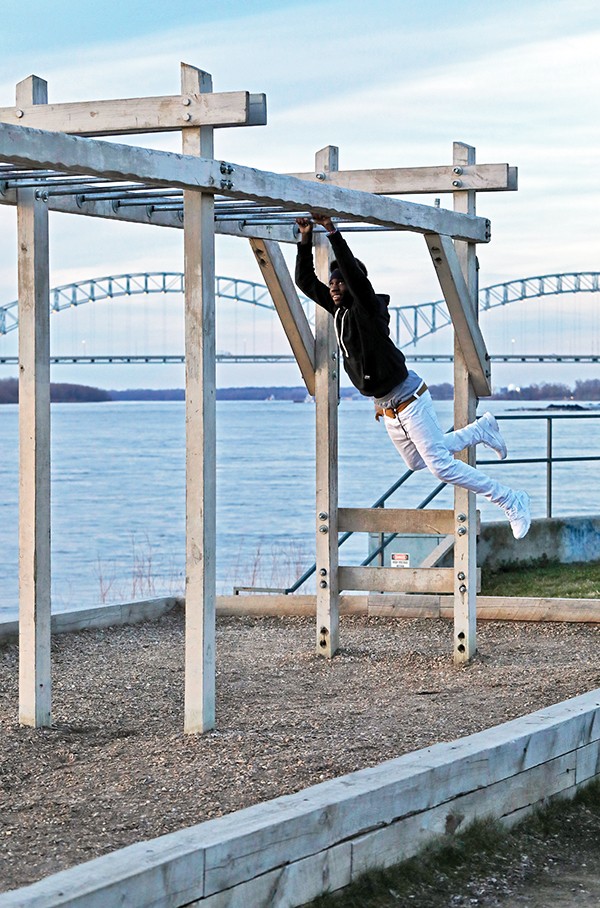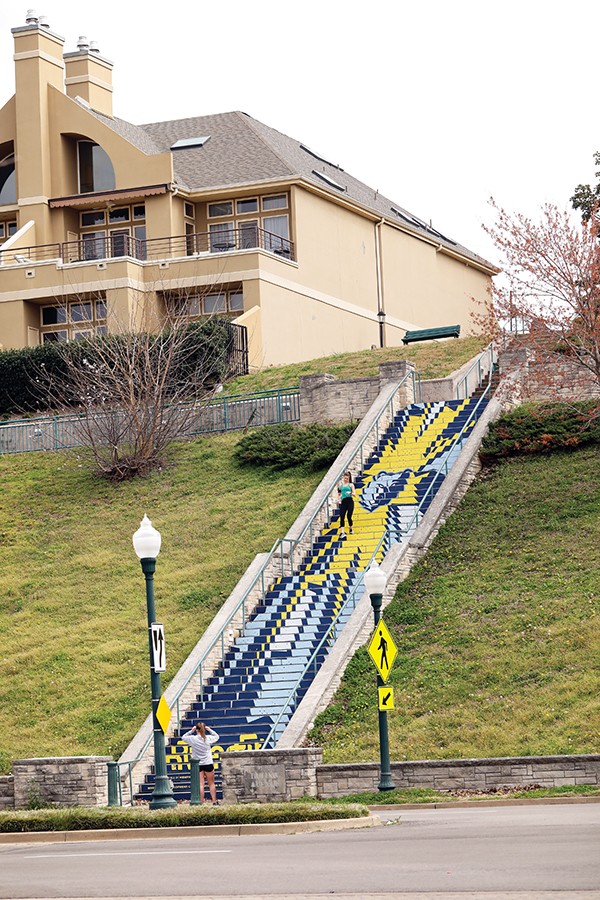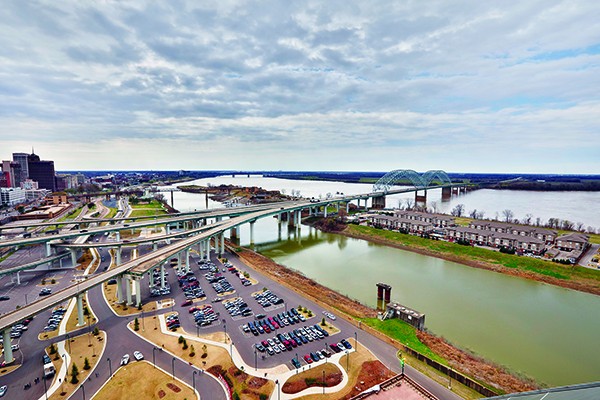The Downtown Memphis riverfront does not suffer from a lack of planning. Over the last quarter-century, a good dozen documents that could rightly be called plans have been completed for the area between the A.W. Willis Bridge and French Fort. But very few built improvements have arisen from these efforts.
— executive summary, Memphis Riverfront Analysis and Recommendations, Jeff Speck 2013
Two words easily sum up the Memphis riverfront: “It’s complicated.”
“If the solution were obvious, it would’ve been done a long time ago.” That’s Alan Crone, chairman of the newly formed Riverfront Task Force (RTF), quoting Mayor Jim Strickland. And that quote refers only to Mud Island River Park.
Crone called it all a Gordian knot. That knot is comprised of smaller knots including centuries-old land claims, historic places, parks, our iconic festival, pedestrians, cars, mayors, council members, developers, anti-developers, money, money, and money. Nevermind that the Mississippi River rises and falls each year by about 57 feet, enough to swallow Hotel Napoleon. All of this has made “doing something” on the river a knot that generations of Memphians just haven’t been able to unravel.
But nearly everyone interviewed for this story talked about the “amazing opportunity” or the “fabulous opportunity” or the “incredible opportunity” the river presents. It was that promise of opportunity that pushed former Memphis Mayor Willie Herenton to form the Riverfront Development Corporation (RDC) back in 2000, according to RDC president Benny Lendermon.
 Justin Fox Burks
Justin Fox Burks
Benny Lendermon
Since then, squadrons of architects, engineers, and planners have been called to our shore of the Big River. They’ve produced piles of plans easier described by weight (or, perhaps, in spent dollars) than the outcomes they’ve produced. Ideas have come, and then they’ve gone, brought to us and carried away on the surging-then-waning current of political and community energy for action.
“Now, for the first time in many decades, the city finds itself in the opposite position,” reads the 2013 Speck plan for the riverfront. “As other American cities have successfully acted upon bold plans to enliven their waterfronts, the citizens and leaders of Memphis have come to recognize that their river’s edge is not all that it could be. There exists a strong sense that change is welcome, but no single past plan offers a clear path for this change … and the last thing the city needs is another plan.”
Yet, here we are. Once again, out-of-town consultants canvass our riverfront formulating what is called a brand new Riverfront Concept Plan. They’re offering more ideas (but new ideas) that will knit the nearly five-mile expanse into some cohesive destination for tourists and locals alike to generate excitement, pride, and, yes, money for the city. To make that happen, there is indeed a new surge of political and community energy for action, riverfront leaders said.
Sound like déjà vu? Well, John Farris, chairman of the RDC, said this time is different. Two private foundations — the Kresge Foundation and the Hyde Foundation — have signed on to help. Also, Mayor Strickland has assembled a task force, which will serve as an arbiter of differing interests on the river and review and choose portions of that new plan, ensuring that “something” will happen.
“It’s not going to happen instantly, but I think it’s going to happen soon,” Farris said. “In the next few years, you’re going to be seeing a lot of change down on the Memphis riverfront, and it’s all going to be good.”
But some barriers exist between ideas and real change. Here are a few of them:

East doesn’t meet West
To many Memphians, downtown and the riverfront are two different things. “That separation is key,” Crone said. “I started saying that in most Memphians’ minds, Riverside Drive is as far away from Main Street as it is from White Station.”
Call it the Bluff Effect; it’s physical and mental. Climbing the bluff from Riverside to Front and points beyond is a real physical challenge to many. It’s an anomaly Lendermon said he has had to explain to out-of-town consultants. “They look at it and go, ‘What elevation change?'” Lendermon said.
But it’s not just about a heart-pulsing walk. Lendermon said there’s also little that invites people to make that trip. “People like having things to do and walking in places that don’t look like they’re abandoned,” he said.
But the Bluff Effect also relies on a deep, more intrinsic need in Memphis: a car.
“Most of the surveys we do [about riverfront issues] say the same thing: parking, parking, parking,” Crone said.
That was certainly on the mind of Tonya Gollat in January. She and two friends were walking the riverfront. When asked what advice she’d give leaders on the riverfront, she said “parking.”
“You want people to come down here, but where am I going to park?” Gollat asked. “They do have all this [gesturing at the Beale Street Landing lot], but it’s pay parking and it’s blocked off. People are not going to do it. That’s a waste.”

The Promenade and the “Overton heirs”
Besides any ethereal barriers to connecting downtown to the riverfront, there is another that is, indeed, invisible but very real.
To see it, let’s dial the wayback machine to the city’s beginning. The founders, including John Overton, decreed a wide, vacant space atop the bluff from Union to some point north (Crone said the deed is a little unclear) would remain dedicated to public use.
So, doing any development on the “promenade” has been a thorny legal bush that has entangled and, ultimately, bested development and developers stretching back to Reconstruction.
“The Chickasaw Bluff, once essential in protecting the city from the Mississippi’s rising waters, now makes it difficult for pedestrians to see or even get near the river,” reads a 2004 study on the promenade area by Cooper, Robertson, and Partners.
Public comments in that document called for “unique restaurants like ESPN Zone,” “quaint shops,” “restaurants with river views,” coffee houses, sidewalk cafes, museums, a pier, and more. So, the Cooper, Robertson plan called for some private development.
But the Supreme Court ruled against any private development on the promenade back in the 1960s. The notion was stymied here again around 2004 by public outcry against it.
“So, you’ve got the Overton legacy,” said Crone. “Then you have the Army Corps of Engineers, who has sway on what goes on on the river. Then, you have the Coast Guard, which has sway on what goes on on the river. So, people say, well, I just don’t see why they just can’t XYZ? Well, it’s probably not because they (being the city) doesn’t want to. It’s because you’ve got a lot of hurdles to overcome, assuming price is no object. It’s just very complicated.”

The RDC
Lendermon said that public opposition to private development on the promenade and the formation of Friends for Our Riverfront was “where the RDC starting going South.
“That’s where we started losing [Memphis City Council] support,” Lendermon said. “At first, everyone was behind [the RDC], then it became like guerrilla warfare to get projects done.”
Virginia McLean, who founded Friends for Our Riverfront (FFOR), said she formed the group to give Memphians a voice on the public lands of the Memphis riverfront. She said leaders began to see the riverfront as a money maker instead of a public amenity.
“Our position has always been that we have incredibly great bones for our riverfront,” McLean said. “It doesn’t have to cost a lot of money. It doesn’t have to have big, silver-bullet projects.”
After the FFOR-led public outcry about the riverfront project, former Mayor Herenton, who appointed Lendermon to lead the RDC, fell out with the council, Lendermon said. “So, if you wanted projects to go through, you didn’t want Herenton to be there helping to support it.” The RDC was left walking a tightrope, Lendermon said, and all of a sudden his group and his work became controversial and, thus, an issue blocking the riverfront’s development.
That controversy certainly followed the RDC through the construction of Beale Street Landing, by far the biggest project the group has managed. The boat dock and public space started with a price tag of $10.4 million but ballooned to a final cost of $43.5 million. Lendermon said the cost changed because the project changed and was not over budget.
Defending the Landing, Lendermon said dockings there this year will generate $42 million of economic impact. Also, he said, about $2.75 million will go to city tax coffers, which is about $500,000 more than the city is paying on the project’s debt every year. But Lendermon said that’s not the point.
“It wasn’t built to be a break-even project,” Lendermon said. “It was built to be a park project. It was built to be an amenity.”
That project and many years of consecutive operating budget overruns have put the RDC in the crosshairs for some Memphis politicians. Former council members Wanda Halbert and Harold Collins both floated the idea of bringing RDC-controlled operations back under the city’s umbrella. In 2014, Memphis Mayor A C Wharton called for the organization to become more financially sustainable. By October 2014, the RDC began its “River Vision 2020” plan, which aimed to cut costs and find new revenue streams.
Farris said the RDC is managing the riverfront for about the same price now that the city was paying 15 years ago. If the city were to do it, “They would’ve been paying a lot more money. From a pure contracting standpoint, we’re able to act a little bit quicker and more easily than the city as far as contracting and responding to issues that arise down on the riverfront,” Farris said. “We don’t have to go through a long procurement process to do work down on the riverfront.”
But the RDC has shrunk over the last few years. Revenue and expenses to the RDC basically halved from 2011 to 2015, according to tax documents. In 2011, the group brought in about $12.4 million and spent $13.2 million. In 2015, the RDC brought in about $6.6 million and spent $6.7 million.
During that time, Lendermon’s salary (another point on which the RDC has been criticized) has remained steady. In 2011, Lendermon made a base salary of $230,589. In 2014, the RDC paid Lendermon a total compesation package of $223,191.
City taxpayers have subsidized the RDC since its inception in 2000, and last year that contract cost $3.1 million. Though the IRS identifies the RDC as an economic development agency, Lendermon said the group hasn’t really done any development projects other than Beale Street Landing. He said the RDC mainly maintains the parks — making repairs, cutting grass, and providing security.
All of this was — before the RDC — the job of the now-defunct Memphis Parks Commission. If Lendermon’s job was to maintain the riverfront parks as a member of city staff, he’d be the highest paid person at Memphis City Hall. In 2016, Memphis Police Department (MPD) director Michael Rallings was paid $219,000. Mayor Jim Strickland was paid just more than $170,000.
But RDC chairman Farris said comparing Lendermon’s salary to the mayor isn’t fair. “The mayor is not running the riverfront; he’s a public official,” Farris said. “He’s elected by the public. Benny works for a nonprofit.”
Farris said the RDC board chose Lendermon’s salary based on a 2014 report from the Memphis-based Centre Group. That report based his salary, in part, on RDC’s revenues of around $12 to $13 million, which are now around half of that. It also based it upon Lendermon’s length of time in the role.
In 2014, the group said Lendermon should make between $203,000 and $230,000 wth a performance bonus of 25 percent. The firm compared Lendermon’s salary to other nonprofit executives at the time, including Memphis Convention and Visitors Bureau president Kevin Kane ($326,844), Memphis Tomorrow president Blair Taylor ($237,120), Memphis Chamber president John Moore ($352,539), Reid Dulberger, president of the Memphis and Shelby County Economic Development Growth Engine ($180,000), Downtown Memphis Commission (DMC) president Paul Morris ($175,000), and Laura Morris, executive director of the Shelby Farms Conservancy ($126,716).
Terence Patterson, the new president of the DMC, made $190,000 in 2015, his first year. For the last three years, his group has managed Beale Street for the city, maintaining facilities and coordinating security plans, finances, and events. Last year, the Memphis Zoological Society got $2.9 million to manage the city’s zoo animals and exhibits. In 2015, zoo CEO Chuck Brady made $404,023.
Farris said what the RDC pays Lendermon is “a pretty good value for what he brings to the riverfront. The key reason why I think Benny is so perfectly situated to lead that effort down there is because he has so much institutional knowledge about the riverfront,” Farris said. “He fishes out on the Mississippi River. He is a river guy. He knows all that stuff backwards and forwards. We’re very fortunate to have him right now.”
With a talented, connected, and independent board, well-paid staffers, and years of experience dealing with riverfront issues, some have asked: If we have the RDC, why do we need a task force for riverfront development?
“A task force appointed by the mayor is in a much superior position to say to everybody, to the RDC, to Memphis in May, to Friends for Our Riverfront, and the DMC: I don’t care who it is — everything is on the table,” Crone said. “It’s maybe trite to say, but we really need to throw away all the paradigms and throw away all the preconceived notions about what we think about when we think about the riverfront. We’ve got to be open to change, because I think we’ve maxed out our current use and vision of the riverfront.”
Tom Lee Park
Tom Lee Park is the “worst,” said Lendermon. “Everyone knows I call [Tom Lee Park] the worst waterfront park in America, and it still is. And I built it.”
Lendermon was the city’s director of public works when the Army Corps of Engineers built a dyke at the base of bluff to protect South Bluffs homes. For about $4 million, Lendermon directed the building of the grassy, 21-acre section of the park atop that dyke.
The construction allowed for the major expansion of the Memphis in May festival, which, up until the rest of the park was built, had been bursting at the seams at the original, four-acre Tom Lee Park where Beale Street Landing is today.
Lendermon said Tom Lee Park is a “great festival park,” but there’s no shade, no restrooms, and no place to gather. He said, “It’s like pasture land on the edge of the river,” and it has “so much more potential.”
But changes, like adding trees or buildings, would hinder the stages, crews, trucks, grills, and more that pile into the park in the weeks before, during, and after Memphis in May. That leaves the park in a state of halted development.
Memphis in May president Jim Holt said his organization brings 160,000 people to the riverfront each year, and he looks forward to new plans for the area.
“We look forward to opportunities to expand our program activities in Tom Lee Park, our festival home for over 40 years, and other improved public space which may become available with an enhanced and developed riverfront,” Holt said.
 Justin Fox Burks
Justin Fox Burks
looking South from Bass Pro Shops at the Pyramid
The Opportunities
Changes and additions, including Riverline, Civic Commons, and a new direction for the Beale Street Landing restaurant are all under discussion. Despite all the issues facing the riverfront, there is, indeed, opportunity there. Two projects are underway now that will bring real change to the Memphis riverfront — and probably this year.
Work is ongoing to make walkable the river-facing stretch of trail on the west side of Bass Pro Shops at the Pyramid. That project is only one part of an overall plan that will stitch the entire riverfront into a connected, walkable stretch.
Signs will soon be posted for the Riverline project, which will direct pedestrians along the walkway stretching from the north end of Greenbelt Park to Big River Crossing. The RDC hired Copenhagen-based Gehl, an urban planning firm, to thread together what they call “an unbraided cord” of a riverfront from north to south. “[The riverfront] ties together here and there, but the idea is to gather it together,” Lendermon said. “[Gehl has] come up with a neat symbolic marking system to do that.”
Also, that east-west/promenade situation is getting a little love. Last year the city got a $5 million Reimagine the Civic Commons grant from national foundations to tie together some of those assets on the public promenade. That project hopes to thread together the area that includes the Cossitt Library, Memphis Park, and Mississippi River Park in to the Fourth Bluff.
One of those projects, unveiled at a RDC meeting last week, will create a new recreation area for Mississippi River Park. The new section would incorporate tree houses, climbing structures, and a large meadow for play.
That plan, which is set for an area just south of the Memphis Visitor Center, could also bring a pop-up park to Riverside Drive which would include basketball courts, a skating rink, and a space for food trucks. That part of the plan, which has not yet received final approval, would be placed on Riverside Drive, shutting down one block of the street from May through August. Work is expected to start on the project this fall.
The Riverfront Bar & Grill, the restaurant inside Beale Street Landing, could be reimagined soon with some fresh ideas by a Memphis-famous restaurateur.
Lendermon told RDC members last week that the restaurant will likely open for the season in April, as it does each year. But this summer, things could change. Lendermon said he is working on a new concept for the spot with a restaurateur “that everyone in this room would know.” However, he said no major change would come until the consultants have finished their work.
Studio Gang and the New Plan
In January, the RDC hired Studio Gang, a renowned “architecture and urbanism practice” based in Chicago, to form the new Riverfront Concept Plan. The firm will present its findings to the Mayor’s Riverfront Task Force at the end of that 12-week process.
From there, the task force will review options from the plan in a series of public meetings. Crone said the group will prioritize the best (and, perhaps, easiest) recommendations and then set them forth to the Memphis City Council, which will have the final word on funding any riverfront projects.
Crone said the riverfront needs Overton-Park-level passion. “We need someone … to create for us that kind of amenity that — 100 years from now — people will be so passionate about that they’re willing to lay down in front of a car to protect it,” Crone said. “We have a world-class amenity in Overton Park, and that’s what we need down [on the riverfront]. Right now we don’t have that.”